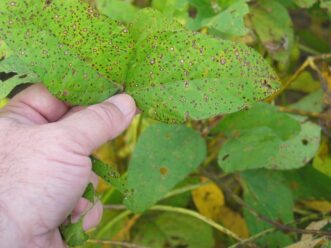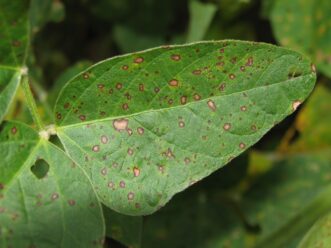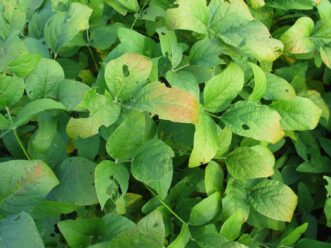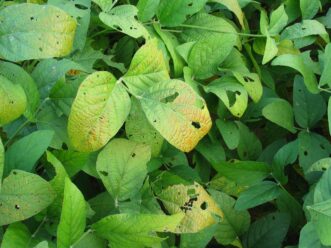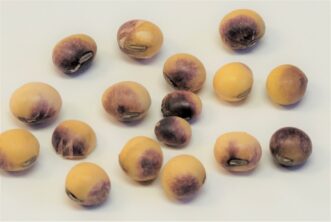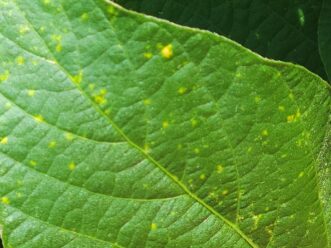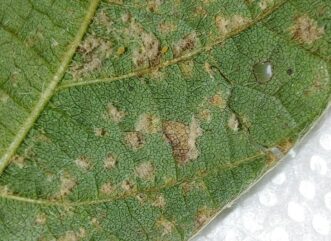Foliar fungal diseases can cause significant yield losses in South Carolina soybeans. The degree of yield loss depends upon several factors, including variety selection, environmental conditions, and cropping history of the field, which is directly correlated to, the levels of inoculum present in a field.4 Optimal management of foliar diseases in soybeans depends on precise and timely scouting, including accurate identification of the present diseases and estimates of their current levels of severity. This publication is designed to assist soybean producers and consultants in successfully identifying and managing the most common foliar soybean diseases in South Carolina. For more help identifying foliar soybean diseases, consult your local Agronomic Extension Agent. The following six diseases are the most common foliar fungal diseases for soybeans grown in South Carolina.
Frogeye Leaf Spot
Causal Agent: Frogeye leaf spot is caused by the fungus Cercospora sojina.
Symptom Description: Frogeye leaf spot symptoms occur on the upper leaf surface and are very distinct. They are generally circular lesions up to ¼ inch in diameter with a white to grey center and dark reddish-brown margins.4 Distinct light-green halos may form around the edge of young lesions. As the lesions age, the center may turn darker and eventually fall out (figures 1 and 2). This is referred to as shot holing. Mild symptoms may occur in midseason and then become more severe after flowering. Lesions may occur on pods and stems.
Biology: This fungus overwinters in infected seeds and soybean debris left in the field by last year’s crop. Dispersion onto the new crop is by splashing rain.4 In the right weather conditions (very overcast or rainy weather), extremely susceptible cultivars can be almost totally defoliated by Frogeye leaf spot. Frogeye leaf spot is more of a problem in the Mid-South than in South Carolina, where extensive spraying with strobilurin (QoI) fungicides has led to the development of populations of the fungus resistant to that mode of action.4,6
Control: Varieties range from almost immune to moderately susceptible to highly susceptible. Control is achieved by planting resistant varieties, using high-quality seed, and destroying soybean debris in the fall. South Carolina growers are fortunate in that most MG VII and VIII soybean cultivars sold in South Carolina have high levels of resistance to the races of the Frogeye leaf spot found in South Carolina. Foliar fungicide sprays immediately after flowering can help limit the incidence and severity of Frogeye leaf spot but provide economical cost returns only on very susceptible varieties when environmental conditions are favorable for extensive disease development. Rotating fields to crops other than soybean and tillage practices that bury soybean crop residue will help reduce inoculum levels.3 Continuous no-tilling of soybean will create the highest levels of disease pressure.3,6
Cercospora Leaf Blight and Purple Seed Stain
Causal Agent: Cercospora leaf blight and purple seed stain are caused by the fungus Cercospora kikuchii.
Symptom Description: Symptoms of Cercospora leaf blight can be difficult to distinguish from nutrient deficiencies or ozone damage. Infection by the fungus can occur early in the growing season, but typically symptoms appear only late in the growing season.1 Symptoms can include elongated, dark red lesions on petioles, which normally occur after seed set, and premature defoliation of the upper canopy may occur during pod fill. Infected leaves appear to be reddish-purple or bronze (figures 3 and 4) with reddish-purple lesions on major veins on the underside of leaves, especially after flowering. Discoloration worsens as plants mature.4 Infected leaves often appear to be leathery. Pods may exhibit round reddish-purple lesions that later turn purple/black. Infected seeds will exhibit a distinctly purple stain over some or all of the seed coat (figure 5).1
Biology: This fungus overwinters in soybean leaf debris and the seedcoats of infected soybeans. Warm, wet weather with late morning dews favor disease development.4
Control: If infected seeds are to be planted, they need to be treated with a fungicide. Several foliar fungicides effectively control this disease, but predicting severity so that preventive sprays can be made only when needed is difficult.1,6 Populations of Cercospora kikuchii have been observed to be resistant to the strobilurin group of fungicides. Some soybean varieties appear less susceptible than others; however, reliable lists of resistant varieties are unavailable. As with many fungal leaf diseases, Cercospora kikuchii overwinters on crop debris. Rotations to nonhost crops and tillage help reduce inoculum levels.
Target Spot
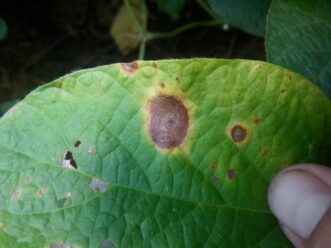
Figure 6. Target spot on a leaf. Image credit: Jonathan Croft, Clemson University Cooperative Extension Service.
Causal agent: Target spot is caused by the fungus Corynespora cassiicola. This fungus also causes Target spot on cotton. The target spot symptoms on tobacco are caused by a fungus in the genera Alternaria.1,4
Symptoms: Symptoms include round to irregular lesions (figure 6). As lesions mature, they may develop alternating light and dark concentric rings, i.e., a target spot.4 Lesions may be ½ inch or greater in diameter and often have a yellow halo. Lesions can be numerous on a leaf and may overlap or merge. Necrotic tissue often falls out, creating a “shot-hole” effect. When the disease is severe, lesions can form rapidly, merge, and cause defoliation.1,4
Biology: This disease appears to be on the increase in the last several years in the southeastern United States. It has an extensive host range and infects many plant species, including cotton. The fungus overwinters primarily on cotton or soybean debris in the field and can survive in a fallow field for two years. The disease appears to be favored by wet weather in the mid to late season, and severity is worse in fields where the canopy has been filled.1
Control: Many varieties exhibit some resistance to Target spot, however, a reliable rating for many varieties is unavailable. Where possible, choose a resistant variety. Using foliar fungicides is challenging as disease development and defoliation often occur rapidly.
Brown Spot

Figure 7. Brown spot on a leaf. Image credit: Dan Robinson, Clemson University Edisto Research and Education Center.
Causal Agent: Brown spot is caused by the fungus Septoria glycines.
Symptoms: Symptoms of Brown spot are rather indistinct. Brown spot can occur beginning at the V-2 growth stage,5 occurring on the lower and upper surfaces of leaves. Lesions are irregular in shape and size, with a typical lesion ¼ inch in diameter (figure 7).4 Leaf tissue around lesions turns yellow, often giving it a “halo” effect. Brown spot starts in the lower canopy and moves up the plant as the lower leaves begin to senesce and drop prematurely. Very small fruiting structures called pycnidia are present in the larger lesions. Pycnidia are impossible to see clearly without a magnifying glass.2
Biology: Brown spot is the most common soybean disease in South Carolina. It occurs in almost every field. It overwinters on seed and in crop debris. The severity of Brown spot increases as plants mature and senesce. However, yield losses are usually minimal since photosynthesis in these senescing leaves is no longer efficient. Temperatures near 800 F favor disease development.
Control: Use high-quality seed and destroy soybean debris in the fall. Several fungicides will control Brown spot. Yield losses are typically low and do not warrant control.1 Varieties vary in susceptibility to Brown spot, and no reliable ratings are available for most varieties.
Downy Mildew
Causal Agent: Downy mildew is caused by the fungus Peronospora manshurica.
Symptoms: Only young leaves at the top of the canopy are susceptible to the disease. Symptoms include small light green to yellow lesions on the upper leaf surface (figure 8) with a white tuft of the fungus on the corresponding bottom side of the leaf (figure 9).4 You may need a magnifying glass to see this white tuft. Lesions are usually 1/8 inch to ¼ inch in diameter.
Biology: Downy mildew is very common in South Carolina and usually occurs during periods of three or more days of high humidity or thunderstorms in July and August. Downy mildew may appear suddenly and spread rapidly. The inoculum is airborne and blows in from other affected areas. Pods can be infected but show no symptoms. Infected seeds have a white crust present on the seed surface. When the weather becomes dry, the white tuft on the bottom side of the leaf will shrivel up and fall off, but the yellow spots on the leaf surface will remain, often turning brown and may have yellow/green margins.1 These spots are often mistaken for symptoms of Asian soybean rust (figure 10).
Control: Although the yellow spots may cover a large area of some leaves, yield losses due to downy mildew are minimal.
Asian soybean rust can be differentiated from downy mildew from the pustules on the bottom of the yellow spots associated with Asian soybean rust. Asian soybean rust does not have mycelial tufts on the undersides of lesions. Spraying fungicides for downy mildew is usually not cost-effective unless soybeans are being grown for seed. Seed treatment fungicides can help eliminate seed-borne downy mildew.1 Soybean varieties vary significantly in their susceptibility to downy mildew. Information on current varieties is difficult to obtain, and multiple races of downy mildew are known to exist, making selecting a resistant variety difficult. Destruction of crop residue will help reduce the initial inoculum levels.
Asian Soybean Rust
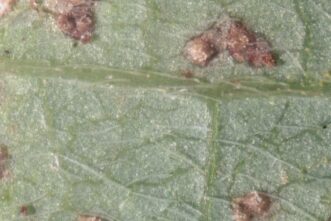
Figure 10. Asian soybean rust. Image credit: Joe Varn, Clemson University Cooperative Extension Service.
Causal Agent: Asian soybean rust is caused by the fungus Phakopsora pachyrhizi.
Symptoms: Asian soybean rust is often first detected when small light green spots appear on the surface of soybean leaves. Small structures resembling volcanoes may be observed directly underneath these light green spots on the underside of the leaf (figure 10). These pustules may be covered by a crust of crystalline material containing hundreds to thousands of spores that can spread across the same leaf, splash, or blow onto neighboring leaves.1
Biology: Asian soybean rust was first discovered in the United States in late 2004. Asian soybean rust is an obligate parasite and can only survive on live host tissue. Therefore, it cannot overwinter anywhere above the freeze line in Florida since its primary hosts, kudzu and soybean, will be killed by a hard frost. In a typical year in South Carolina, Asian soybean rust is not detected on soybean until mid to late August.3 In some years, first detections may not occur until mid-September or even October. Asian soybean rust can cause significant yield losses if it appears in August and favorable weather conditions exist during soybean pod development. Mild temperatures and days with prolonged moisture in the canopy from rain or heavy dews favor Asian soybean rust development.4
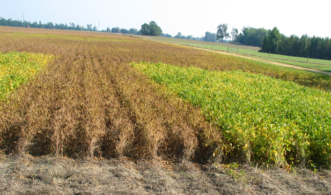
Figure 11. Foliar fungicide treated vs. non-treated plots with Asian soybean rust. Image credit: John Mueller, Clemson University Cooperative Extension Service.
Control: There are no commercially available soybean varieties with resistance to Asian soybean rust. Management of Asian soybean rust is achieved primarily by applying foliar fungicides during or immediately after flowering (figure 11). Most fungicides provide two to three weeks of protection against new infections. Early planting dates and planting early maturing varieties may also help optimize rust management.2
General Principles of Soybean Foliar Disease Prevention and Management
Most major foliar diseases of soybean overwinter on plant debris on the soil surface. No-tillage or conservation tillage may allow higher survival rates, leading to more disease pressure the following year. Any tillage operation that incorporates or helps break down crop debris helps reduce inoculum for foliar diseases such as frogeye leaf spot, brown spot, or target spot. The major exception is Asian soybean rust. The initial inoculum for Asian soybean rust blows in from other areas as far away as Central America.2
The development of most foliar diseases is favored by extended wet periods or consecutive days with heavy or late morning dews. Many diseases become more severe as leaves start to senesce and plants age. In most situations, fungicide sprays can be delayed until at or just after flowering (i.e., growth stages R2 to R3).5 One exception would be Target spot which should be sprayed as soon as it is observed during the growing season. Fungicides are often mixed with insecticides like pyrethroids and sprayed during early pod set for stinkbug control. A single fungicide application is usually sufficient unless weather conditions are very favorable for disease development, such as a hurricane. Any time an extended period of wet weather, such as a hurricane, is projected, it is always better to spray before than after the storm to achieve the highest levels of control.2 Many fungal diseases can be transmitted in the seed or on the seed coat. Using the highest quality seed available is always a good management practice. Fungicidal seed treatments will not offset poor quality seed, nor will they control foliar fungal diseases.
References Cited
- Mueller D, Wise K, Sisson A, Smith D, Sikora E, Bradley C, and Robertson A. A farmer’s guide to soybean diseases. St. Paul (MN): American Phytopathological Society; 2016.
- Mueller J D, Plumblee M. 2021 South Carolina soybean production guide. Clemson (SC): Clemson University Cooperative Extension Service. p. 37–44. https://clemson.app.box.com/s/a27svxqckn50ew65hc502vl3i29x8vbz.
- Mueller J D, Marshall M, editor. 2023 South Carolina pest management handbook for field crops. Clemson (SC): Clemson University Cooperative Extension Service. p. 284–288. https://www.clemson.edu/extension/agronomy/index.html.
- Hartman G L, Rupe JC, Sikora EJ, Domier LL, Davis JA, Steffey KL. Compendium of soybean diseases and pests, 5th ed. St. Paul, (MN): American Phytopathological Society; 2015.
- Plumblee M, Harrelson B. Visual guide to soybean growth stages. Clemson (SC): Clemson Cooperative Extension, Land-Grant Press by Clemson Extension; 2022 Apr. LGP 1144. https://lgpress.clemson.edu/publication/visual-guide-to-soybean-growth-stages/.
- Wise K. Fungicide efficacy for control of soybean foliar diseases. Ames (IA): Crop Protection Network; 2023 Feb. CPN-1019. https://cropprotectionnetwork.org/publications/fungicide-efficacy-for-control-of-soybean-foliar-diseases. doi.org/10.31274/cpn-20190620-014.

